Modified Crack Detection of Sewer Conduit with Low-Resolution Images
Abstract
:1. Introduction
2. Crack Detection Procedure
2.1. Step 1: Read the Image
2.2. Step 2: Enhance the Image
2.3. Step 3: Make the Binary Image
2.4. Step 4: Fill Interior Gaps and Dilate the Crack
2.5. Step 5: Detect the Crack
2.6. Step 6: Overlay the Image
3. Crack Detection Parameters and User Algorithm
3.1. Crack Detection Parameters
3.2. User Algorithm
4. Results and Analysis
5. Conclusions
Author Contributions
Funding
Institutional Review Board Statement
Informed Consent Statement
Data Availability Statement
Conflicts of Interest
References
- Xu, K.; Luxmoore, A.; Davies, T. Sewer pipe deformation assessment by image analysis of video surveys. Pattern Recognit. 1998, 31, 169–180. [Google Scholar] [CrossRef]
- McKim, R.A.; Sinha, S.K. Condition assessment of underground sewer pipes using a modified digital image processing paradigm. Tunn. Undergr. Space Technol. 1999, 14, 29–37. [Google Scholar] [CrossRef]
- Moselhi, O.; Shehab-Eldeen, T. Automated detection of surface defects in water and sewer pipes. Autom. Constr. 1999, 8, 581–588. [Google Scholar] [CrossRef]
- Yang, M.-D.; Su, T.-C. Automated diagnosis of sewer pipe defects based on machine learning approaches. Expert Syst. Appl. 2008, 35, 1327–1337. [Google Scholar] [CrossRef]
- Yang, M.-D.; Su, T.-C.; Pan, N.-F.; Yang, Y.-F. Systematic image quality assessment for sewer inspection. Expert Syst. Appl. 2011, 38, 1766–1776. [Google Scholar] [CrossRef]
- Sinha, S.K.; Fieguth, P.W. Automated detection of cracks in buried concrete pipe images. Autom. Constr. 2006, 15, 58–72. [Google Scholar] [CrossRef]
- Halfawy, M.R.; Hengmeechai, J. Efficient Algorithm for Crack Detection in Sewer Images from Closed-Circuit Television Inspections. J. Infrastruct. Syst. 2014, 20, 04013014. [Google Scholar] [CrossRef]
- Haurum, J.B.; Moeslund, T.B. A Survey on Image-Based Automation of CCTV and SSET Sewer Inspections. Autom. Constr. 2020, 111, 103061. [Google Scholar] [CrossRef]
- Son, B.J.; Jeon, J.R.; Heo, G.H. Image processing algorithm for crack detection of sewer with low resolution. J. Korea Acad. Ind. Coop. Soc. 2017, 18, 590–599. [Google Scholar]
- Heo, G.; Jeon, J.; Son, B. Crack Automatic Detection of CCTV Video of Sewer Inspection with Low Resolution. KSCE J. Civ. Eng. 2019, 23, 1219–1227. [Google Scholar] [CrossRef]
- Zuiderveld, K. Contrast Limited Adaptive Histograph Equalization, Graphic Gems IV; Academic Press Professional: San Diego, CA, USA, 1994; pp. 474–548. [Google Scholar]
- Bradley, D.; Roth, G. Adaptive Thresholding using the Integral Image. J. Graph. Tools 2007, 12, 13–21. [Google Scholar] [CrossRef]
- Soille, P. Morphological Image Analysis: Principles and Applications; Springer: Berlin/Heidelberg, Germany, 1999; pp. 173–174. [Google Scholar]
- Gonzalez, R.C.; Woods, R.E.; Eddins, S.L. Digital Image Processing Using MATLAB. Available online: http://www.gatesmark.com/ (accessed on 3 March 2021).



| Duration | 200 s |
|---|---|
| Frame Rate | 30 |
| Height | 240 |
| Width | 320 |
| Procedures for Crack Detection | Crack Image (c18) | Non-Crack Image (n25) |
|---|---|---|
| Step 1 Read the Image |  |  |
| Step 2 Enhance the Image (CLAHE: Contrast-Limited Adaptive Histogram Equalization) (Parameter: ClipLimit) | 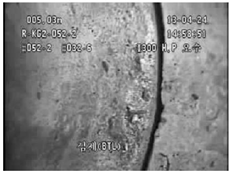 | 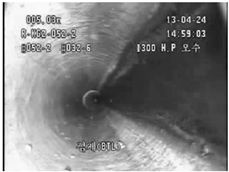 |
| Step 3 Make the Binary Image (Find the Optimum Threshold Value) (Parameter: Sensitivity and Statistic) | 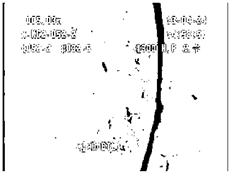 | 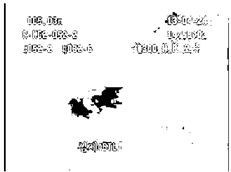 |
| Step 4 Fill Interior Gaps and Dilate the Crack |  | 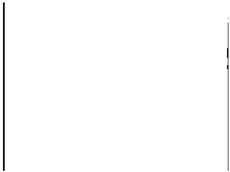 |
| Step 5 Detect the Crack (Complement the Image) (User Algorithm) | 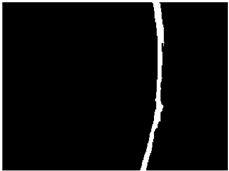 |  |
| Step 6 Overlay the Image | 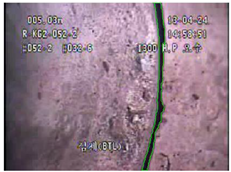 | 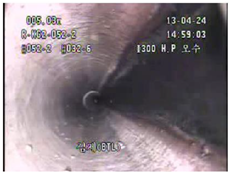 |
| Var. # | Name | Range |
|---|---|---|
| Var. #1 | ClipLimit | 0, 0.00001, 0.0001, 0.01, [0.1:0.1:1] {15} |
| Var. #2 | Sensitivity | [0:0.1:1] (start:spacing:end) {11} |
| Var. #3 | Statistic | Mean, Median, Gaussian {3} |
| (a) Crack Images | ||||||||||||
| Var. #2 | 0.0 | 0.1 | 0.2 | 0.3 | 0.4 | 0.5 | 0.6 | 0.7 | 0.8 | 0.9 | 1.0 | |
| Var. #1 | ||||||||||||
| 0 | 0.0 | 0.0 | 0.0 | 0.0 | 0.0 | 3.6 | 87.3 | 92.7 | 96.4 | 94.5 | 94.5 | |
| 0.00001 | 0.0 | 0.0 | 0.0 | 0.0 | 0.0 | 3.6 | 87.3 | 92.7 | 96.4 | 94.5 | 94.5 | |
| 0.0001 | 0.0 | 0.0 | 0.0 | 0.0 | 0.0 | 3.6 | 87.3 | 92.7 | 96.4 | 94.5 | 94.5 | |
| 0.001 | 0.0 | 0.0 | 0.0 | 0.0 | 1.8 | 5.5 | 78.2 | 90.9 | 96.4 | 94.5 | 94.5 | |
| 0.01 | 0.0 | 0.0 | 0.0 | 0.0 | 0.0 | 5.5 | 52.7 | 92.7 | 98.2 | 100.0 | 98.2 | |
| 0.1 | 0.0 | 0.0 | 0.0 | 0.0 | 0.0 | 5.5 | 45.5 | 90.9 | 98.2 | 100.0 | 100.0 | |
| 0.2 | 0.0 | 0.0 | 0.0 | 0.0 | 0.0 | 5.5 | 47.3 | 90.9 | 98.2 | 100.0 | 100.0 | |
| 0.3 | 0.0 | 0.0 | 0.0 | 0.0 | 0.0 | 5.5 | 49.1 | 90.9 | 98.2 | 100.0 | 100.0 | |
| 0.4 | 0.0 | 0.0 | 0.0 | 0.0 | 0.0 | 5.5 | 49.1 | 90.9 | 98.2 | 100.0 | 100.0 | |
| 0.5 | 0.0 | 0.0 | 0.0 | 0.0 | 0.0 | 5.5 | 49.1 | 90.9 | 98.2 | 100.0 | 100.0 | |
| 0.6 | 0.0 | 0.0 | 0.0 | 0.0 | 0.0 | 5.5 | 49.1 | 90.9 | 98.2 | 100.0 | 100.0 | |
| 0.7 | 0.0 | 0.0 | 0.0 | 0.0 | 0.0 | 5.5 | 49.1 | 90.9 | 98.2 | 100.0 | 100.0 | |
| 0.8 | 0.0 | 0.0 | 0.0 | 0.0 | 0.0 | 5.5 | 49.1 | 90.9 | 98.2 | 100.0 | 100.0 | |
| 0.9 | 0.0 | 0.0 | 0.0 | 0.0 | 0.0 | 5.5 | 49.1 | 90.9 | 98.2 | 100.0 | 100.0 | |
| 1.0 | 0.0 | 0.0 | 0.0 | 0.0 | 0.0 | 5.5 | 49.1 | 90.9 | 98.2 | 100.0 | 100.0 | |
| (b) Non-Crack Images | ||||||||||||
| Var. #2 | 0.0 | 0.1 | 0.2 | 0.3 | 0.4 | 0.5 | 0.6 | 0.7 | 0.8 | 0.9 | 1.0 | |
| Var. #1 | ||||||||||||
| 0 | 100.0 | 100.0 | 100.0 | 100.0 | 100.0 | 100.0 | 65.5 | 25.5 | 70.9 | 94.5 | 98.2 | |
| 0.00001 | 100.0 | 100.0 | 100.0 | 100.0 | 100.0 | 100.0 | 65.5 | 25.5 | 70.9 | 94.5 | 98.2 | |
| 0.0001 | 100.0 | 100.0 | 100.0 | 100.0 | 100.0 | 100.0 | 65.5 | 25.5 | 70.9 | 94.5 | 98.2 | |
| 0.001 | 100.0 | 100.0 | 100.0 | 100.0 | 100.0 | 98.2 | 67.3 | 20.0 | 49.1 | 94.5 | 98.2 | |
| 0.01 | 100.0 | 100.0 | 100.0 | 100.0 | 100.0 | 100.0 | 70.9 | 9.1 | 10.9 | 40.0 | 72.7 | |
| 0.1 | 100.0 | 100.0 | 100.0 | 100.0 | 100.0 | 98.2 | 70.9 | 5.5 | 5.5 | 14.5 | 40.0 | |
| 0.2 | 100.0 | 100.0 | 100.0 | 100.0 | 100.0 | 96.4 | 72.7 | 9.1 | 5.5 | 18.2 | 43.6 | |
| 0.3 | 100.0 | 100.0 | 100.0 | 100.0 | 100.0 | 96.4 | 70.9 | 9.1 | 7.3 | 16.4 | 43.6 | |
| 0.4 | 100.0 | 100.0 | 100.0 | 100.0 | 100.0 | 96.4 | 70.9 | 9.1 | 5.5 | 14.5 | 43.6 | |
| 0.5 | 100.0 | 100.0 | 100.0 | 100.0 | 100.0 | 96.4 | 69.1 | 9.1 | 5.5 | 14.5 | 43.6 | |
| 0.6 | 100.0 | 100.0 | 100.0 | 100.0 | 100.0 | 96.4 | 70.9 | 9.1 | 5.5 | 14.5 | 43.6 | |
| 0.7 | 100.0 | 100.0 | 100.0 | 100.0 | 100.0 | 96.4 | 70.9 | 9.1 | 5.5 | 14.5 | 43.6 | |
| 0.8 | 100.0 | 100.0 | 100.0 | 100.0 | 100.0 | 96.4 | 70.9 | 9.1 | 5.5 | 14.5 | 43.6 | |
| 0.9 | 100.0 | 100.0 | 100.0 | 100.0 | 100.0 | 96.4 | 70.9 | 9.1 | 5.5 | 14.5 | 43.6 | |
| 1.0 | 100.0 | 100.0 | 100.0 | 100.0 | 100.0 | 96.4 | 70.9 | 9.1 | 5.5 | 14.5 | 43.6 | |
| (a) Crack Images | ||||||||||||
| Var. #2 | 0.0 | 0.1 | 0.2 | 0.3 | 0.4 | 0.5 | 0.6 | 0.7 | 0.8 | 0.9 | 1.0 | |
| Var. #1 | ||||||||||||
| 0 | 0.0 | 0.0 | 0.0 | 0.0 | 0.0 | 0.0 | 49.1 | 98.2 | 94.5 | 87.3 | 83.6 | |
| 0.00001 | 0.0 | 0.0 | 0.0 | 0.0 | 0.0 | 0.0 | 49.1 | 98.2 | 94.5 | 87.3 | 83.6 | |
| 0.0001 | 0.0 | 0.0 | 0.0 | 0.0 | 0.0 | 0.0 | 49.1 | 98.2 | 94.5 | 87.3 | 83.6 | |
| 0.001 | 0.0 | 0.0 | 0.0 | 0.0 | 0.0 | 0.0 | 41.8 | 98.2 | 94.5 | 92.7 | 85.5 | |
| 0.01 | 0.0 | 0.0 | 0.0 | 0.0 | 0.0 | 0.0 | 34.5 | 96.4 | 98.2 | 100.0 | 90.9 | |
| 0.1 | 0.0 | 0.0 | 0.0 | 0.0 | 0.0 | 1.8 | 29.1 | 90.9 | 98.2 | 100.0 | 96.4 | |
| 0.2 | 0.0 | 0.0 | 0.0 | 0.0 | 0.0 | 1.8 | 27.3 | 92.7 | 100.0 | 100.0 | 96.4 | |
| 0.3 | 0.0 | 0.0 | 0.0 | 0.0 | 0.0 | 1.8 | 29.1 | 92.7 | 100.0 | 100.0 | 96.4 | |
| 0.4 | 0.0 | 0.0 | 0.0 | 0.0 | 0.0 | 1.8 | 29.1 | 92.7 | 100.0 | 100.0 | 96.4 | |
| 0.5 | 0.0 | 0.0 | 0.0 | 0.0 | 0.0 | 1.8 | 29.1 | 92.7 | 100.0 | 100.0 | 96.4 | |
| 0.6 | 0.0 | 0.0 | 0.0 | 0.0 | 0.0 | 1.8 | 29.1 | 92.7 | 100.0 | 100.0 | 96.4 | |
| 0.7 | 0.0 | 0.0 | 0.0 | 0.0 | 0.0 | 1.8 | 29.1 | 92.7 | 100.0 | 100.0 | 96.4 | |
| 0.8 | 0.0 | 0.0 | 0.0 | 0.0 | 0.0 | 1.8 | 29.1 | 92.7 | 100.0 | 100.0 | 96.4 | |
| 0.9 | 0.0 | 0.0 | 0.0 | 0.0 | 0.0 | 1.8 | 29.1 | 92.7 | 100.0 | 100.0 | 96.4 | |
| 1.0 | 0.0 | 0.0 | 0.0 | 0.0 | 0.0 | 1.8 | 29.1 | 92.7 | 100.0 | 100.0 | 96.4 | |
| (b) Non-Crack Images | ||||||||||||
| Var. #2 | 0.0 | 0.1 | 0.2 | 0.3 | 0.4 | 0.5 | 0.6 | 0.7 | 0.8 | 0.9 | 1.0 | |
| Var. #1 | ||||||||||||
| 0 | 100.0 | 100.0 | 100.0 | 100.0 | 100.0 | 100.0 | 72.7 | 32.7 | 90.9 | 100.0 | 100.0 | |
| 0.00001 | 100.0 | 100.0 | 100.0 | 100.0 | 100.0 | 100.0 | 72.7 | 32.7 | 90.9 | 100.0 | 100.0 | |
| 0.0001 | 100.0 | 100.0 | 100.0 | 100.0 | 100.0 | 100.0 | 72.7 | 32.7 | 90.9 | 100.0 | 100.0 | |
| 0.001 | 100.0 | 100.0 | 100.0 | 100.0 | 100.0 | 100.0 | 61.8 | 21.8 | 80.0 | 100.0 | 100.0 | |
| 0.01 | 100.0 | 100.0 | 100.0 | 100.0 | 100.0 | 100.0 | 69.1 | 1.8 | 20.0 | 54.5 | 85.5 | |
| 0.1 | 100.0 | 100.0 | 100.0 | 100.0 | 100.0 | 100.0 | 72.7 | 3.6 | 7.3 | 18.2 | 40.0 | |
| 0.2 | 100.0 | 100.0 | 100.0 | 100.0 | 100.0 | 100.0 | 72.7 | 3.6 | 3.6 | 18.2 | 41.8 | |
| 0.3 | 100.0 | 100.0 | 100.0 | 100.0 | 100.0 | 100.0 | 70.9 | 3.6 | 0.0 | 18.2 | 41.8 | |
| 0.4 | 100.0 | 100.0 | 100.0 | 100.0 | 100.0 | 100.0 | 70.9 | 3.6 | 0.0 | 18.2 | 41.8 | |
| 0.5 | 100.0 | 100.0 | 100.0 | 100.0 | 100.0 | 100.0 | 72.7 | 3.6 | 0.0 | 18.2 | 41.8 | |
| 0.6 | 100.0 | 100.0 | 100.0 | 100.0 | 100.0 | 100.0 | 72.7 | 3.6 | 0.0 | 18.2 | 41.8 | |
| 0.7 | 100.0 | 100.0 | 100.0 | 100.0 | 100.0 | 100.0 | 72.7 | 3.6 | 0.0 | 18.2 | 41.8 | |
| 0.8 | 100.0 | 100.0 | 100.0 | 100.0 | 100.0 | 100.0 | 72.7 | 3.6 | 0.0 | 18.2 | 41.8 | |
| 0.9 | 100.0 | 100.0 | 100.0 | 100.0 | 100.0 | 100.0 | 72.7 | 3.6 | 0.0 | 18.2 | 41.8 | |
| 1.0 | 100.0 | 100.0 | 100.0 | 100.0 | 100.0 | 100.0 | 72.7 | 3.6 | 0.0 | 18.2 | 41.8 | |
| (a) Crack Images | ||||||||||||
| Var. #2 | 0.0 | 0.1 | 0.2 | 0.3 | 0.4 | 0.5 | 0.6 | 0.7 | 0.8 | 0.9 | 1.0 | |
| Var. #1 | ||||||||||||
| 0 | 0.0 | 0.0 | 0.0 | 0.0 | 9.1 | 34.5 | 76.4 | 90.9 | 96.4 | 98.2 | 96.4 | |
| 0.00001 | 0.0 | 0.0 | 0.0 | 0.0 | 9.1 | 34.5 | 76.4 | 90.9 | 96.4 | 98.2 | 96.4 | |
| 0.0001 | 0.0 | 0.0 | 0.0 | 0.0 | 9.1 | 34.5 | 76.4 | 90.9 | 96.4 | 98.2 | 96.4 | |
| 0.001 | 0.0 | 0.0 | 0.0 | 0.0 | 7.3 | 36.4 | 81.8 | 92.7 | 96.4 | 98.2 | 96.4 | |
| 0.01 | 0.0 | 0.0 | 0.0 | 3.6 | 10.9 | 30.9 | 63.6 | 94.5 | 98.2 | 100.0 | 98.2 | |
| 0.1 | 0.0 | 0.0 | 0.0 | 3.6 | 14.5 | 38.2 | 50.9 | 90.9 | 96.4 | 100.0 | 100.0 | |
| 0.2 | 0.0 | 0.0 | 0.0 | 3.6 | 14.5 | 34.5 | 54.5 | 90.9 | 96.4 | 100.0 | 100.0 | |
| 0.3 | 0.0 | 0.0 | 0.0 | 3.6 | 12.7 | 34.5 | 54.5 | 90.9 | 96.4 | 100.0 | 100.0 | |
| 0.4 | 0.0 | 0.0 | 0.0 | 3.6 | 12.7 | 34.5 | 54.5 | 90.9 | 96.4 | 100.0 | 100.0 | |
| 0.5 | 0.0 | 0.0 | 0.0 | 3.6 | 12.7 | 34.5 | 54.5 | 90.9 | 96.4 | 100.0 | 100.0 | |
| 0.6 | 0.0 | 0.0 | 0.0 | 3.6 | 12.7 | 34.5 | 54.5 | 90.9 | 96.4 | 100.0 | 100.0 | |
| 0.7 | 0.0 | 0.0 | 0.0 | 3.6 | 12.7 | 34.5 | 54.5 | 90.9 | 96.4 | 100.0 | 100.0 | |
| 0.8 | 0.0 | 0.0 | 0.0 | 3.6 | 12.7 | 34.5 | 54.5 | 90.9 | 96.4 | 100.0 | 100.0 | |
| 0.9 | 0.0 | 0.0 | 0.0 | 3.6 | 12.7 | 34.5 | 54.5 | 90.9 | 96.4 | 100.0 | 100.0 | |
| 1.0 | 0.0 | 0.0 | 0.0 | 3.6 | 12.7 | 34.5 | 54.5 | 90.9 | 96.4 | 100.0 | 100.0 | |
| (b) Non-Crack Images | ||||||||||||
| Var. #2 | 0.0 | 0.1 | 0.2 | 0.3 | 0.4 | 0.5 | 0.6 | 0.7 | 0.8 | 0.9 | 1.0 | |
| Var. #1 | ||||||||||||
| 0 | 100.0 | 100.0 | 100.0 | 100.0 | 100.0 | 100.0 | 74.5 | 45.5 | 32.7 | 63.6 | 94.5 | |
| 0.00001 | 100.0 | 100.0 | 100.0 | 100.0 | 100.0 | 100.0 | 74.5 | 45.5 | 32.7 | 63.6 | 94.5 | |
| 0.0001 | 100.0 | 100.0 | 100.0 | 100.0 | 100.0 | 100.0 | 74.5 | 45.5 | 32.7 | 63.6 | 94.5 | |
| 0.001 | 100.0 | 100.0 | 100.0 | 100.0 | 100.0 | 100.0 | 69.1 | 50.9 | 30.9 | 56.4 | 87.3 | |
| 0.01 | 100.0 | 100.0 | 98.2 | 98.2 | 90.9 | 85.5 | 70.9 | 45.5 | 23.6 | 20.0 | 49.1 | |
| 0.1 | 100.0 | 100.0 | 100.0 | 96.4 | 94.5 | 90.9 | 60.0 | 21.8 | 9.1 | 9.1 | 29.1 | |
| 0.2 | 100.0 | 100.0 | 100.0 | 96.4 | 96.4 | 90.9 | 60.0 | 20.0 | 7.3 | 9.1 | 29.1 | |
| 0.3 | 100.0 | 100.0 | 100.0 | 96.4 | 96.4 | 90.9 | 63.6 | 18.2 | 3.6 | 7.3 | 25.5 | |
| 0.4 | 100.0 | 100.0 | 100.0 | 96.4 | 96.4 | 90.9 | 63.6 | 18.2 | 3.6 | 3.6 | 25.5 | |
| 0.5 | 100.0 | 100.0 | 100.0 | 96.4 | 96.4 | 90.9 | 63.6 | 18.2 | 3.6 | 3.6 | 25.5 | |
| 0.6 | 100.0 | 100.0 | 100.0 | 96.4 | 96.4 | 90.9 | 63.6 | 18.2 | 3.6 | 3.6 | 25.5 | |
| 0.7 | 100.0 | 100.0 | 100.0 | 96.4 | 96.4 | 90.9 | 63.6 | 18.2 | 3.6 | 3.6 | 25.5 | |
| 0.8 | 100.0 | 100.0 | 100.0 | 96.4 | 96.4 | 90.9 | 63.6 | 18.2 | 3.6 | 3.6 | 25.5 | |
| 0.9 | 100.0 | 100.0 | 100.0 | 96.4 | 96.4 | 90.9 | 63.6 | 18.2 | 3.6 | 3.6 | 25.5 | |
| 1.0 | 100.0 | 100.0 | 100.0 | 96.4 | 96.4 | 90.9 | 63.6 | 18.2 | 3.6 | 3.6 | 25.5 | |
| Statistic | Mean | Median | Gaussian | |
|---|---|---|---|---|
| Sample | ||||
| c5 | 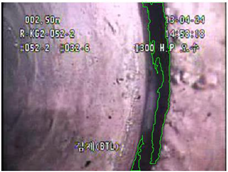 | 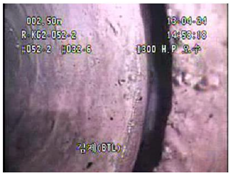 | 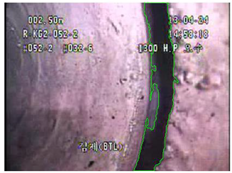 | |
| c6 |  | 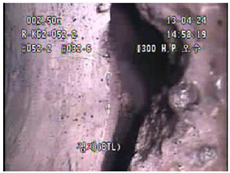 |  | |
| c7 |  |  |  | |
| c10 |  | 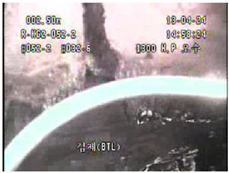 | 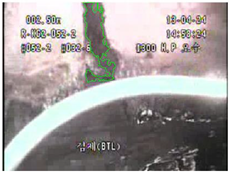 | |
| c15 |  |  | 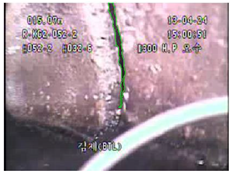 | |
| c22 | 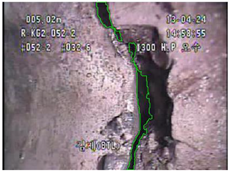 |  | 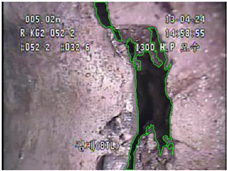 | |
| Original Image (c1) | Image at Step 4 (c1) |
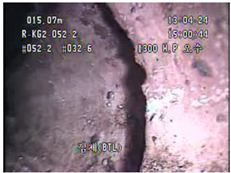 | 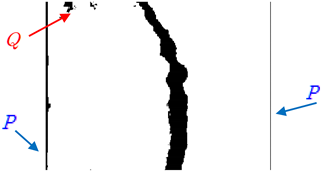 |
| Original Image (c16) | Image at Step 4 (c16) |
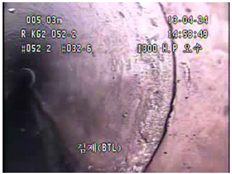 |  |
| Original Image (n15) | Image at Step 4 (n15) |
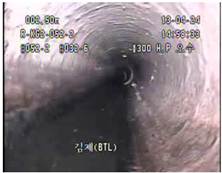 |  |
| Original Image (n23) | Image at Step 4 (n23) |
 | 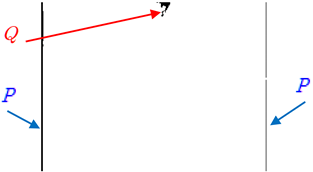 |
| Input: Image f(i, j) at Step 4 Output: Crack image g(i, j) (1 ≤ i≤sz(1), 1 ≤ j ≤ sz(2)) (sz(1): Height of image, sz(2): width of image) | |
|---|---|
| 1 | Using image f(j, i) in Step 4 |
| 2 | for (k = 1 to No. of crack) |
| 3 | Truncate columns at left and right ends (which are ‘P’ in Table 8) |
| 4 | for (i = 1 to sz(1)) |
| 5 | Calculate length of cracks |
| 6 | end |
| 7 | for (j = 1 to sz(2)) |
| 8 | Calculate width of cracks |
| 9 | end |
| 10 | Width of cracks : longer than 3 mm (8 pixels) &, shorter than 160 pixels Length of cracks : More than 9 mm (24 pixel) |
| 11 | end |
| Images | |
|---|---|
| Bad Results | c24, c52 (2 Images, 3.6%) |
| Good Results | c14, c16, c23, c25, c31, c32, c39, c40, c46, c51 (10 Images, 19.2%) |
| Excellent Results | Processed Image Count Excluding Upper Results (43 images, 78.2%) |
| Images | |
|---|---|
| Bad Results | n3, n5, n30 (3 Images, 5.4%) |
| Excellent Results | Processed Image Count Excluding Upper Results (52 images, 94.6%) |
| Original Image and Crack Image (c1) | Original Image and Crack Image (c3) | ||
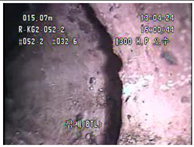 | 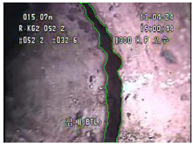 |  |  |
| Original Image and Crack Image (c4) | Original Image and Crack Image (c7) | ||
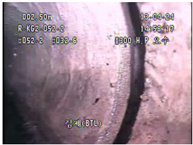 | 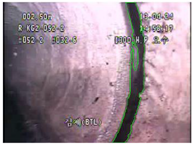 |  | 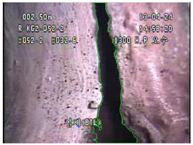 |
| Original Image and Crack Image (c8) | Original Image and Crack Image (c10) | ||
 |  | 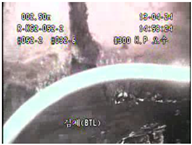 | 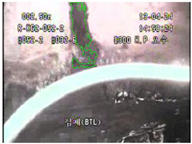 |
| Original Image and Crack Image (c15) | Original Image and Crack Image (c17) | ||
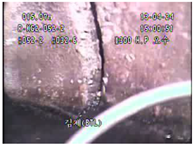 |  | 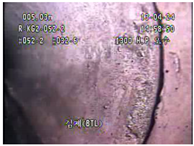 | 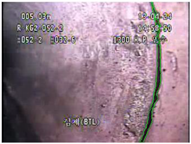 |
| Original Image and Crack Image (c20) | Original Image and Crack Image (c30) | ||
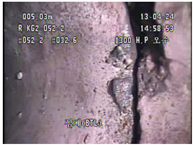 |  | 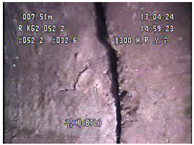 | 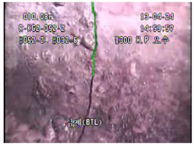 |
| Original Image and Crack Image (c47) | Original Image and Crack Image (c48) | ||
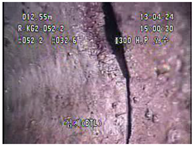 |  | 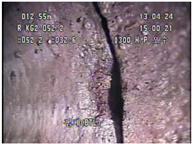 |  |
| Original Image and Crack Image (c14) | Original Image and Crack Image (c16) | ||
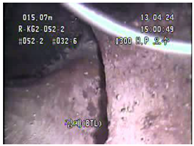 | 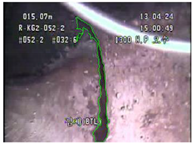 | 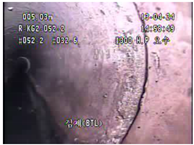 | 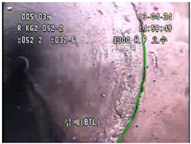 |
| Original Image and Crack Image (c23) | Original Image and Crack Image (c25) | ||
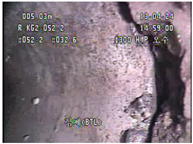 | 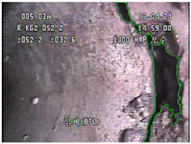 | 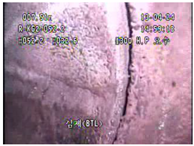 |  |
| Original Image and Crack Image (c31) | Original Image and Crack Image (c32) | ||
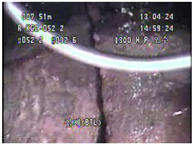 |  | 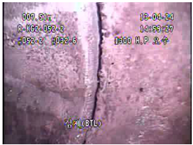 | 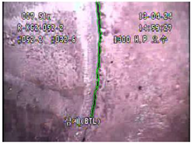 |
| Original Image and Crack Image (c39) | Original Image and Crack Image (c40) | ||
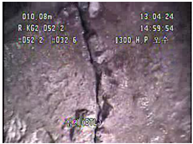 | 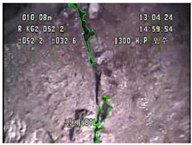 |  | 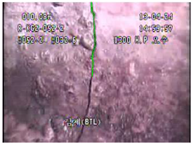 |
| Original Image and Crack Image (c46) | Original Image and Crack Image (c51) | ||
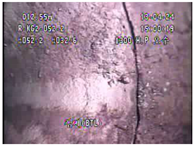 | 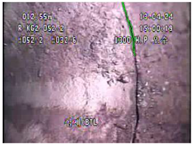 | 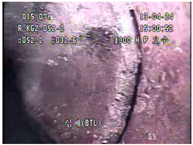 | 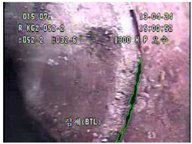 |
| Original Image and Crack Image (c24) | Original Image and Crack Image (c52) | ||
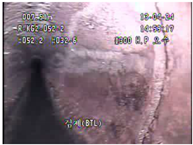 | 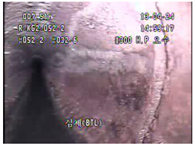 | 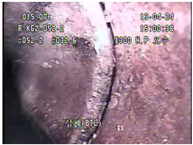 | 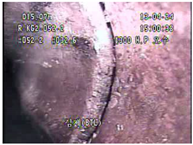 |
| Original Image and Non-Crack Image (n3) | Original Image and Non-Crack Image (n5) | ||
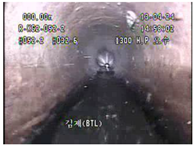 |  | 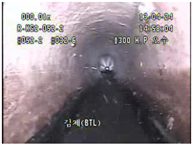 |  |
| Original Image and Crack Image (n30) | |||
 | 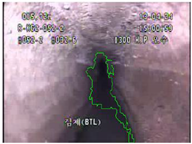 | ||
Publisher’s Note: MDPI stays neutral with regard to jurisdictional claims in published maps and institutional affiliations. |
© 2021 by the authors. Licensee MDPI, Basel, Switzerland. This article is an open access article distributed under the terms and conditions of the Creative Commons Attribution (CC BY) license (http://creativecommons.org/licenses/by/4.0/).
Share and Cite
Son, B.J.; Cho, T. Modified Crack Detection of Sewer Conduit with Low-Resolution Images. Appl. Sci. 2021, 11, 2263. https://doi.org/10.3390/app11052263
Son BJ, Cho T. Modified Crack Detection of Sewer Conduit with Low-Resolution Images. Applied Sciences. 2021; 11(5):2263. https://doi.org/10.3390/app11052263
Chicago/Turabian StyleSon, Byung Jik, and Taejun Cho. 2021. "Modified Crack Detection of Sewer Conduit with Low-Resolution Images" Applied Sciences 11, no. 5: 2263. https://doi.org/10.3390/app11052263
APA StyleSon, B. J., & Cho, T. (2021). Modified Crack Detection of Sewer Conduit with Low-Resolution Images. Applied Sciences, 11(5), 2263. https://doi.org/10.3390/app11052263






